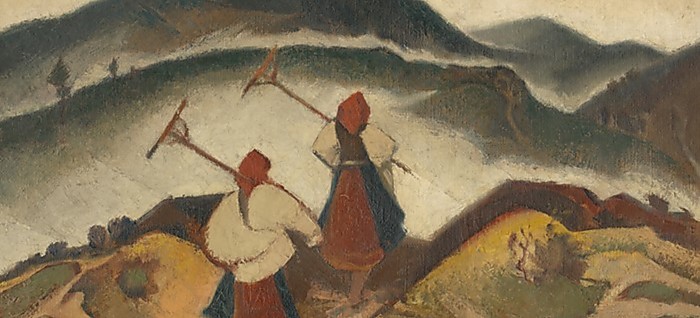
Martin Benka is noted for introducing the aesthetics of folk culture into the formal language of Slovak Modernism at the beginning of the 20th century. Through his impressionist beginnings he progressed to inventing his own pictorial style of monumental expressiveness. His inclination to nature was in a strong contrast to the contemporary purist movements such as the German Bauhaus and Soviet constructivism whose stylistic priorities lay in functionalism.
Martin Benka was born into poverty in a village of Kiripolec (present day Kostoliste) in Western Slovakia. He began to draw at a very young age. As a young man he trained In Vienna as a painter-decorator. His spare time was spent visiting galleries and practicing his own art. Despite his meagre earnings he was still able to buy pigments, brushes, canvases and paper.
Prague Student
As there was only so much he could learn by himself, he started applying for an apprenticeship with accomplished painters who had their own studio and held classes. Accepted by the renowned Czech landscape painter Kalvoda, he moved to Prague in 1910. His first paintings were inspired by impressionism. His work concentrates on studies of natural motifs in various lighting conditions. Kalvoda praised his excellence in depicting forest scenery.
Homeland
A significant stage of Benka’s career as an artist began in 1913 when he journeyed to his native Slovakia. Travelling across the countryside, he visited remote mountain regions and the local rural communities, making spontaneous sketches outdoors.
Martin Benka lived in Prague for thirty years but regularly travelled to his homeland. Around 1915 this fusion of influences resulted in landscapes in the decorative art nouveau style which later evolved into abstracted landscape motifs with decorative compositional arrangement and ornamental line.
Man and Landscape
In the early 1920s Benka journeyed to several European countries where he familiarized himself with the works of great masters. Seeing this variety of different styles encouraged him to dramatize his own mode of expression. At this period his typical monumental style begins to take shape. Benka’s goal was to amplify the substance through the reduction of expressive means and simplification of forms. He now includes a human element in his mountain landscape and focuses on the dramatic interaction between nature and man. The landscape is the background to the struggle between the two.
Unlikely Heroes
From 1925 Benka exhibited internationally and this period is also a landmark in his artistic development as his interest gradually shifted from landscapes with figures to figurative painting. His monumentalized paintings concentrating on the human are characterized by their epic symbolism. The figures as well as the landscapes they inhabit are generalized and stylized. Man and nature form an organic entity. Through the flatness of surface, bold delineation of forms and warm earthy colours Benka translates his own emotions experienced in nature into his works.
Folk Art
Benka’s work was inspired by Slovakian traditions and folk culture, including ballads and songs. The main protagonists of his paintings are people living in communion with nature. Colours and shapes derived from colour schemes and figurative motifs of folk art.
Benka’s brush transforms the trivial into monumental: a common man becomes a hero, an ordinary woman turns into a heroine, a mundane task is a noble deed. But Benka’s hero is void of political associations. The heroism he presents has a timeless quality: the ability to remain true to oneself and to one’s roots.
Thank you for reading this article! If you have any further questions about this topic please contact us.
